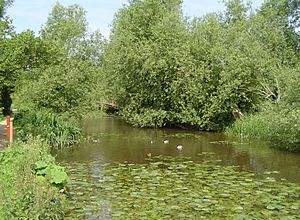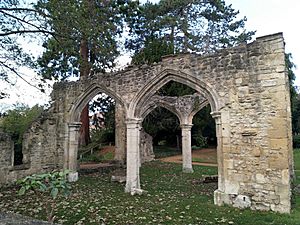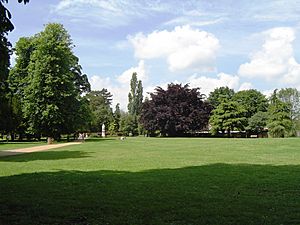Abingdon Abbey facts for kids

Abingdon Abbey was a large Benedictine monastery. It was also called St Mary's Abbey. You could find it in Abingdon, England. This area was historically part of Berkshire. Today, it is in Oxfordshire.
Contents
History of Abingdon Abbey
How the Abbey Started
People believe the abbey was founded in 675. It was started either by Cissa or his nephew Hean. Cissa was a viceroy, like a governor, for King Centwine of Wessex. The abbey was built to honor the Virgin Mary. It was home to twelve Benedictine monks. Cissa was also buried here.
Growth and Challenges
Many kings of the West Saxons gave money and land to the abbey. Because of this, it became very important and wealthy. However, the Danes destroyed it during the time of King Alfred. King Alfred then took over its lands. He felt the monks had not thanked him enough for defeating their enemies.
By the 950s, the abbey was in a poor state. But around 954, King Eadred appointed Æthelwold as the abbot. Æthelwold later became a bishop. He was a key leader in the English Benedictine Reform. This was a movement to improve monasteries in England. Abingdon became the second most important place for this reform.
The abbey kept many important documents. There are 136 charters, or official papers, from Saxon kings. The Chronicle of the Monastery of Abingdon was also written here. This book tells the abbey's history.
Abbey's Land and Leaders
Abingdon Abbey owned many lands. One important place was The Abbey in Sutton Courtenay. This was a monastic grange. It was like a large farm and office for managing the abbey's lands. The monks likely managed it themselves.
After the Norman Conquest, new abbots led the abbey. One was Faritius, who was a doctor to King Henry I of England. Another was Richard of Hendred. He even attended an important meeting called the Second Council of Lyon in 1272.
The last abbot was Thomas Pentecost. He was one of the first to accept the Royal Supremacy. This meant the king, not the Pope, was the head of the church in England. In 1538, he signed over the monastery to the king. The abbey was very rich, earning a lot of money each year.
Notable Burials
Several important people were buried at Abingdon Abbey. These include:
- Ælfric of Abingdon (later moved to Canterbury Cathedral)
- Sideman (bishop)
- Margaret, Countess of Pembroke
- Fulk FitzRoy
- Robert D'Oyly and his wife Ealdgyth
- Siward (Abbot of Abingdon)
- Ralph Basset and his father Thurston Ralph Bassett
- John Grey, 2nd Viscount Lisle
- Mary of Waltham
Extant Buildings
What Remains Today
Sadly, there is nothing left of the main abbey church. The ruins you see in the Abbey Gardens today are called Trendell's Folly. They were built in the 1800s. Some stones might have come from St Helen's Church.
However, some other buildings from the monastery still stand. These include:
- The Abbey Exchequer (where money was kept)
- The timber-framed Long Gallery
- The Abbey bakehouse
- The Abbey gateway
- St John's hospitium (a hostel for pilgrims)
- The Church of Saint Nicolas
These buildings are cared for by the Friends of Abingdon Civic Society. One of the original fireplaces from the abbey was moved. It is now in a place called Lacies Court.
Today, the Unicorn Theatre is located in part of the old Abbey.





